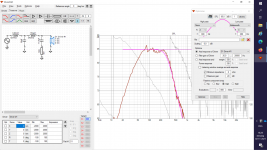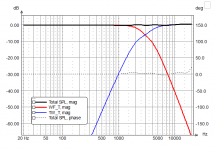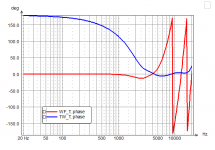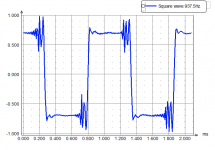Unfortunately this type of subtractive delay crossover can only be done in the digital domain. But it is definitely interesting.
Regards
Charles
Regards
Charles
Hello Charles,
Its looks as if we have a communication error here. What I have displayed is the electric transfer function of the woofer lowpass with the values SR provided, and then loaded with 8 Ohms. It is basically a modified second order, not third order. 3.9mH and 0.78mH are too far removed from each others value to make the woofer LP third order electric.
Of course this does not show the acoustic transfer function of the woofer-filter combo, hence my asking for the SPL curves of the filtered woofer section.
And yes, I am fully aware of the fact that the filter should be loaded with a measured .zma file. Just for fun I will load the filter with a .zma file one of these days.
Its looks as if we have a communication error here. What I have displayed is the electric transfer function of the woofer lowpass with the values SR provided, and then loaded with 8 Ohms. It is basically a modified second order, not third order. 3.9mH and 0.78mH are too far removed from each others value to make the woofer LP third order electric.
Of course this does not show the acoustic transfer function of the woofer-filter combo, hence my asking for the SPL curves of the filtered woofer section.
And yes, I am fully aware of the fact that the filter should be loaded with a measured .zma file. Just for fun I will load the filter with a .zma file one of these days.
This is what a real measured woofer (.frd) and real measured impedance (.zma) data yield: almost textbook BUT3 @290Hz
We can see in the last picture of post #26 that acoustic delay is used.
By this it is possible to get quasi-transient-perfect XOs while maintaining higher order slopes for both drivers, with no overshoot in the FR.... and with good phase-tracking around the XO.
The higher section always is the delayed one.
But you can delay the tweeter electrically as well, no need for more offset that get the acoustic centers aligned. While hard to realize with passive XOs it is quite feasible with active allpass filters in the case of an XO at sufficient high frequency (like for tweeter) -- for low XO freqs the number of allpass cells explodes, though.
Here an example of such a filter with delay (acoustic target, of course) which is 4th order on both slopes, no overshoot and 0° phase offset at XO, it took three 2nd-order all-passes on the tweeter together with that slightly deformed individual FR responses.
The pre-ringing we see in the square-wave plot is because the tweeter allpass delay was limited to ~20kHz (to save allpass cells) but the sampling rate for the sim is 96kHz.
By this it is possible to get quasi-transient-perfect XOs while maintaining higher order slopes for both drivers, with no overshoot in the FR.... and with good phase-tracking around the XO.
The higher section always is the delayed one.
But you can delay the tweeter electrically as well, no need for more offset that get the acoustic centers aligned. While hard to realize with passive XOs it is quite feasible with active allpass filters in the case of an XO at sufficient high frequency (like for tweeter) -- for low XO freqs the number of allpass cells explodes, though.
Here an example of such a filter with delay (acoustic target, of course) which is 4th order on both slopes, no overshoot and 0° phase offset at XO, it took three 2nd-order all-passes on the tweeter together with that slightly deformed individual FR responses.
The pre-ringing we see in the square-wave plot is because the tweeter allpass delay was limited to ~20kHz (to save allpass cells) but the sampling rate for the sim is 96kHz.
Attachments
We can see in the last picture of post #26 that acoustic delay is used.
This can also be seen in the formula for the highpass.
Regards
Charles
Hello everyone,
Is it right to continue here with a suitable amplifier
for Time Alignment speakers - or you need to start the topic in
Amplifiers Solid state ?
Is it right to continue here with a suitable amplifier
for Time Alignment speakers - or you need to start the topic in
Amplifiers Solid state ?
- Home
- Loudspeakers
- Multi-Way
- Good Step Response with passive filters higher than first order



